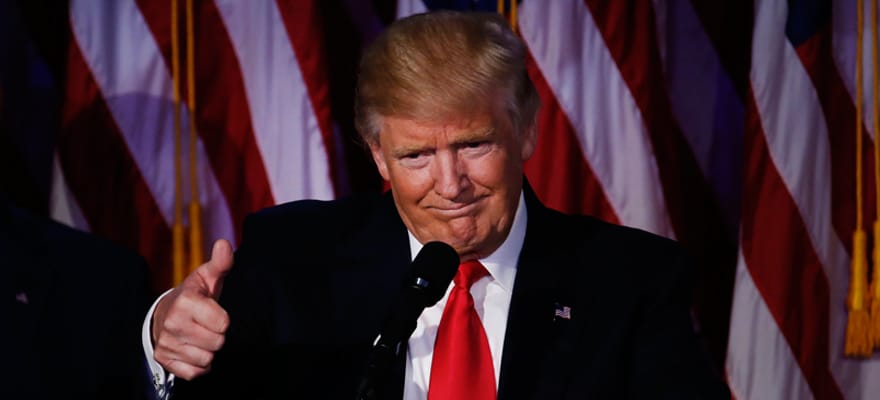Plain and simply stated, election Volatility was just noise. Although market commentators were eager to label the limit down reaction in the S&P 500 overnight as Donald Trump’s fault, the subsequent rebound highlights a degree of confidence in the outlook. In fact, many market participants are rapidly coming around to the realization that a Trump victory is not necessarily bad for the economy, but quite the opposite.
Before becoming President-elect, Trump proffered a $1 trillion fiscal spending plan to revitalize America’s ailing infrastructure, setting the stage for the biggest fiscal stimulus since the days of Franklin Delano Roosevelt’s “New Deal.”
While America struggles to completely shake off the ghosts of the 2008-2009 financial crisis, the election of Donald Trump was the first step towards a greater focus on domestic conditions versus America’s faltering role in policing the globe. However, the election is proving to just be noise in the grander scheme, especially as the Federal Reserve inches towards another rate hike.
Volatility Leaves the Dollar Mostly Unchanged
The US dollar has been a hot topic over the last six weeks as a steep rally in the currency coincided with rising speculation of the first additional step towards interest rate normalization since 2015.
While the prospect of a November hike was roundly dismissed thanks to its proximity to the US election, December remains on the table. Comparing before and after the election, so far, the likelihood of December action has only dipped moderately from 76.30% on Tuesday to 71.50% on Wednesday per Fed Funds futures. Although Europe woke up in a panic following a volatile Asian trading session after the close of US polling, the subsequent price action is very telling about the market overreaction.
For traders, especially those with a tendency to focus on longer-term portfolio management, the reaction reeks of “noise,” or unnecessary clamor related to a development that is largely positive for the US dollar. The currency itself reflected this very notion, with the US dollar index reversing from deep losses earlier in the session to climb back into positive territory on the day.
As of writing, 1-day US dollar index performance was positive, up nearly 0.50% on the day to 98.36. With the world still spinning on its axis, the gloomy outlook predicted by Trump’s detractors has so far failed to manifest. While the results of the election are likely to be a contentious issue over the coming weeks, it is merely a distraction from the bigger picture.
Bigger Picture Changes Are Absent
The election makes it easy to miss the forest for the trees. Instead of focusing on the trajectory of the American economy and the monetary policy that has been the predominant driver of activity, market participants have been hung up on the potential instead of reality. On a headline basis, American fundamentals are largely improving. Even though unemployment structurally remains high considering weak labor force participation, inflation is back on the rise and manufacturing is back in expansionary territory.
The election of Donald Trump is unlikely to dramatically impact that progress negatively. In fact, proposed fiscal measures may mean higher growth while review of trade deals may help reverse the longstanding trade deficit. A higher velocity of money through the American economy will help rates gradually rise over time, bolstering upside momentum in the US dollar.
While easy to pin the fortunes of the economy on the President, in truth, Trump is likely to have limited immediate impact whereas monetary policy will be the driver over the next two months. Unless Equities start to accelerate downwards over the coming weeks, there is a high probability that the Federal Reserve’s increasingly hawkish leanings will materialize in a rate hike.
As such, the primary driver of the economy over the near-term will not necessarily be politics, but instead interest rates. If economic data continues to match or exceed expectations over the next five weeks, a rate hike is not guaranteed, but highly probable. However, post-inauguration, the math might change markedly, especially considering Trump’s sharp criticism of the Central Bank.
Trump’s disdain for the Federal Reserve has not gone unnoticed. His scathing condemnation of Fed Chair Janet Yellen and the highly accommodative policy measures undertaken by the Central Bank may be one of his early targets after inauguration. If the Federal Reserve opts to take a more hawkish tone during the December meeting, it could allay fears that Donald Trump would shake up the institution. Furthermore, if they establish a clearer timeline for the future of interest rate increases, it could avert a collision course with the President-elect.
Looking Ahead
Based on the current economic environment, the noise and volatility overnight should be largely ignored. Nothing has changed from the perspective of policy despite highly divisive rhetoric. Going forward, the key to the outlook will hinge upon the data. Considering its stated data dependency and the weight of the world on its shoulders, the buck stops with the Federal Reserve, not the President of the United States.
Should they decide to move, the reaction in markets will be more relevant instead of the noise of politics, with the US dollar finally breaking higher from its multi-year range.

Idan Levitov
This article is written by Idan Levitov, VP trading of anyoption.com. Learn more about the markets here.











